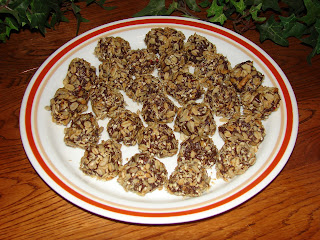
Butternut squash and pomegranates ready to be processed.
Our pomegranates and Butternut squash needed to be picked and processed during walnut harvest this year. The cool, wet weather was making them split and if not processed immediately would be lost. So several of the days it was too wet to be in the orchard harvesting walnuts we were processing the pomegranates and squash.
We make juice out of the pomegranates. First all the seeds have to be separated from the skin and membranes. Then the seeds are steamed in our juicing kettle. The juice is then poured into canning jars and sealed.
Pomegranates that were not splitting open could be saved a few weeks until harvest was complete. We had over 100 pomegranates on our tree this year! In the grocery store we seen they were selling for $1.99 each. That is too much too let go to waste.
The winter squash that have developed splits we bake and then freeze for later use. Squash that is not damaged can be stored through the winter if keep in a cool, dry place.
A fruit cellar or basement is ideal for long-term storage of canned goods, fruit and vegetables. We have neither. The shelves in our kitchen are shallow and do not hold much so what does not fit there we store on shelves in the hallway and other rooms of the house. The squash and other produce that we keep until they are used goes on the floor along the walls as the lowest part of the room is the coolest.
Winter squash is one of our favorite things to grow as there are many ways of using it in cooking. Squash can be used in any recipe that calls for pumpkin from bread, pies, cakes and cookies to just eating it plain after it is baked.
Our favorite pie recipe uses honey instead of sugar. It has a smoother texture than when made with sugar.
Also we usually skip making the crust and make only the pudding. It cuts down on the calories and the pudding is the best part anyway.
Below is our recipe for squash/pumpkin pudding:
2 cups cooked winter squash or pumpkin
3 eggs
1/2 cup powdered milk
1 cup water
1/2 teaspoon salt
1/2 teaspoon ginger
1 teaspoon cinnamon
1/2 teaspoon nutmeg
1/2 teaspoon cloves
1/4 cup honey
1 tablespoon molasses
1 teaspoon vanilla
Blend all ingredients together. We use a blender but a mixer will also work. Pour into 2-quart casserole dish and bake at 450 for 10 minutes. Then lower the temperature to 350 for 40 more minutes or until a knife poked in the center comes out clean.
To make into a pie pour pudding mixture into a 9-inch pie deep dish pie shell and bake the same as above.
One more reason we like to bake is it helps warm up the house on the cold fall and winter days. The bonus is it also makes the house smell good.
 Column to share recipes, gardening projects, crafts, home decorating ideas, activities for families to do and more.
Column to share recipes, gardening projects, crafts, home decorating ideas, activities for families to do and more.

